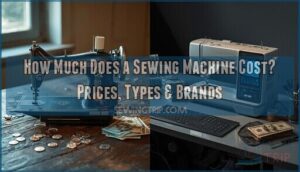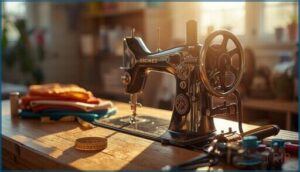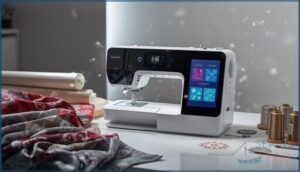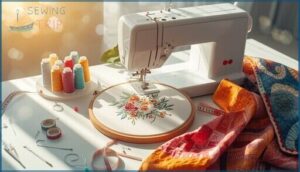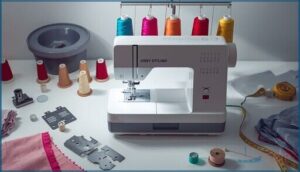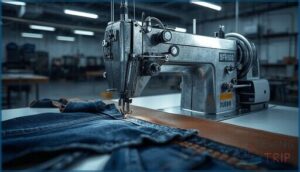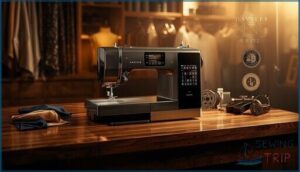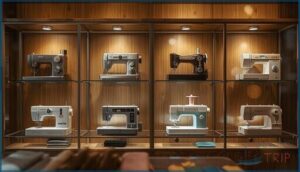This site is supported by our readers. We may earn a commission, at no cost to you, if you purchase through links.
You can grab a basic sewing machine for the same price as dinner out—around $100—or drop the cost of a used car on a professional-grade model that costs $10,000 or more. That massive spread isn’t arbitrary. It reflects real differences in what these machines can do, how long they’ll last, and whether they’ll frustrate you or become your most-used tool.
A $150 mechanical Singer manages basic alterations and simple projects just fine, but it won’t tackle thick upholstery or intricate embroidery like a $3,000 Bernina will.
Understanding what drives these prices—from brand reputation and computerized features to build quality and included accessories—helps you spend wisely instead of overpaying for features you won’t use or cheaping out on a machine that quits after six months.
Table Of Contents
Key Takeaways
- Sewing machines range from $100 basic mechanicals to $10,000+ professional models, with your actual needs—not feature lists—determining the smartest investment for your projects.
- Used machines slash costs by 40-60% compared to new, but factor in maintenance expenses ($40-80 yearly) and accessory costs ($50-100 over time) before committing your budget.
- Mechanical models ($100-500) deliver reliable durability without digital complexity, while computerized machines ($400-4,000+) offer automation and sophisticated features that justify higher prices only if you’ll use them.
- Brand reputation matters beyond marketing—Singer, Brother, and Janome maintain parts availability for 10+ years and deliver 72% higher customer trust through proven service networks.
How Much Does a Sewing Machine Cost?
Sewing machines range wildly in price, from under $100 to well over $10,000, depending on what you need them to do. Your budget depends on your skill level, the features you can’t live without, and whether you’re buying new or used.
Let’s break down what you’ll actually pay at different price points and experience levels.
Average Price Ranges
You’ll find sewing machine prices spanning from $100 to over $10,000, depending on what you’re after. Entry-level mechanical models run $100 to $300—perfect for breaking free from alterations shops. Mid-range computerized options sit between $300 and $700, while high-end embroidery and quilting machines start around $700 and climb past $5,000 for professional-grade capabilities that put you in complete control.
Understanding social issues can also impact consumer choices.
Typical Costs by User Level (Beginner to Professional)
Your skill level dictates your sewing budgets more than you’d think. Beginner expenses start at $100–$200 for basic mechanical models, putting control in your hands without breaking the bank. Ready for machine upgrades? Mid-range computerized sewing machines run $400–$800. Expert sewers command $1,200–$3,000 high-end computerized options, while professional setups with skill level pricing reach $3,000–$10,000+.
Here’s what each tier delivers:
- Beginner: $100–$300 mechanical or entry computerized machines with essential stitches
- Intermediate: $400–$1,200 hybrid models adding memory functions and embroidery-lite features
- Expert hobbyist: $1,200–$3,000 extensive stitch libraries and large embroidery hoops
- Semi-professional: $2,000–$8,000 industrial-grade durability for home studios
- Full professional: $3,000–$25,000+ all-inclusive systems with warranties and service contracts.
When researching sewing machine costs, consider systematic review methods to find the best options for your needs.
Cost Comparison: New Vs. Used Machines
New machines command full retail—$100–$400 entry models, $1,000–$3,000 high-end—while used sewing machine options slash costs 40%–60%. Refurbished options deliver $60–$240 savings on beginner gear.
Market fluctuations and warranty impact resale value; well-serviced Berninas retain 70%–90% average cost. Price trends favor buyers hunting certified units with service records, turning sewing machine cost into strategic advantage.
Types of Sewing Machines and Their Prices
Not every sewing machine fulfills the same purpose, and that shows up in the price tag. Your choice depends on what you want to make and how much control you need over your projects.
Here’s what you can expect from each major type and what you’ll pay.
Mechanical Sewing Machines
Mechanical sewing machines strip away digital distractions and put pure control in your hands. Basic mechanical sewing machines cost between $100 and $250 new, while used units run $60 to $150. You’ll master sewing techniques through direct mechanical parts interaction, handling thread management and fabric selection without computer interference.
Mid-range models with enhanced machine maintenance features climb to $250–$500, delivering sturdy performance that won’t quit.
Computerized Sewing Machines
Computerized machines bring sewing automation and machine learning to your fingertips, starting at $150 for entry-level units with essential stitch patterns.
Mid-range computerized sewing machines delivering powerful digital quilting and computerized embroidery run $400 to $1,000.
High-end computerized sewing machine prices climb to $4,000+ for professional-grade performance. You’ll pay more, but sophisticated features and firmware updates give you long-term control over every project.
Embroidery and Quilting Machines
Embroidery machines and quilting machines hand you creative control, with entry-level embroidery costs starting around $199 and mid-range quilting techniques support running $600–$2,500. Here’s what you’ll pay:
- Basic embroidery machines with built-in designs: $199–$2,000
- Combination embroidery-quilting units: $399–$3,000
- High-end quilting machines with large beds: $1,000–$6,000
- Professional embroidery-only models: $5,000–$15,000
- Commercial multi-needle systems: $10,000–$100,000+
Thread selection, stitch quality, and hoop size directly impact your machine comparison decision.
Serger and Overlocker Machines
Sergers overlockers slice raw edges and stitch seams simultaneously, giving you professional fabric handling at $150–$1,200. Basic three-thread serger machines cost $150–$300, while midrange computerized sewing machines with differential feed run $400–$900. You’ll pay $2,000+ for industrial models.
Factor in thread management supplies and serger maintenance—replacement blades and presser feet add $20–$60 annually, boosting sewing efficiency and overlocker tips mastery.
Industrial and Heavy-Duty Machines
Heavy-duty sewing machines built for commercial use range from $800 to $15,000, with most industrial models falling between $2,000 and $6,000. Single-needle units for upholstery start at $1,200, while automated, multi-needle systems exceed $4,000.
Industrial pricing reflects metal frames and servo motors, which reduce per-hour costs despite higher upfront investments. Budget 3–5% annually for machine maintenance and service contracts.
Factors Influencing Sewing Machine Prices
Not all sewing machines are priced the same, and understanding why helps you spend smarter. Several key factors determine whether you’ll pay $100 or $5,000 for a machine.
Let’s break down what drives the price tag so you can make an informed choice.
Brand Reputation and Model Lineup
Brand reputation isn’t just hype—it’s your safety net. Singer, Brother, and Janome dominate because 72% of experienced sewists trust brands with solid customer support and accessible manuals. These sewing machine brands command premium pricing through proven model updates and market share muscle. Their price strategy reflects decades of brand loyalty:
- Top brands refresh 60% of models every five years
- 83% of buyers link higher prices to better service
- Repeat purchases jump 40–65% with broad model lineups
- Quality brands maintain parts availability for 10+ years
Features and Built-in Functions
More built-in stitches mean higher computerized sewing machine price tags. Entry-level machines offer 7–30 stitch options, while sophisticated models pack 50–200 presets.
Automatic threading cuts setup time, embroidery designs expand creative freedom, and quilting functions with needle control let you tackle specialized projects.
These sewing machine features separate $150 basics from $1,500+ powerhouses—sophisticated functions and technology cost real money but release serious capability.
Build Quality and Materials
What you sew on matters. Steel frame materials and metal components in mid-range machines extend service life 15–25% over plastic builds, directly impacting mechanical sewing machine price and durable machines’ stitch quality. Needle durability and fabric compatibility hinge on construction:
- Steel frames power through canvas and denim without flex
- Aluminum bed plates cut friction, extending needle life 30%
- Brass tension mechanisms maintain consistency across 50,000 stitches
- ABS housings balance cost with impact resistance
Sewing machine quality starts with what’s underneath.
Accessories and Add-Ons Included
Once you move beyond frame construction, what’s in the box reshapes your budget. 68% of new machines ship with accessory bundles—needles, presser feet, or cases—adding 12–18% to the sticker price.
Computerized models often pack 71% more presser feet than mechanicals, while embroidery machines throw in USB interfaces and software trials. Those sewing notions and machine interfaces aren’t freebies; they’re baked into bundle pricing, inflating costs before you thread your first bobbin.
Sewing Machine Prices by Brand
Brand matters when you’re putting money on the table. Some names have built their reputation on reliability, while others win over sewers with innovation or affordability.
Here’s what you can expect to pay across the most popular sewing machine brands.
Singer Sewing Machine Costs
Singer sewing machine prices span a wide territory. You’ll find mechanical models perfect for launching your sewing rebellion at $120–$250 new, while computerized units command $350–$900 with sophisticated stitch databases. Cost factors include warranty options (usually 2–5 years), machine upgrades like USB connectivity, and sewing accessories bundled in. Mid-range Singer machines cluster around $300–$450, balancing features and budget.
- Entry-level mechanical: $120–$250 new, delivering straight-stitch mastery
- Computerized models: $350–$900 with LCD interfaces and pattern memory
- Embroidery-capable units: $600–$1,500 for creative freedom
Brother Sewing Machine Costs
Brother sewing machine prices give you firepower across every skill level. Entry-level Brother machines start at $100–$250, delivering solid machine durability and sewing speed for beginners.
Mid-range Brother machines ($250–$600) pack computerized features and varied needle types. Computerized units reach $700–$1,500 with embroidery capability.
Thread quality stays consistent across models, while accessory costs add $20–$60 per package—factor that into your budget.
Janome, Bernina, and Juki Price Ranges
Janome, Bernina, and Juki price ranges reveal where your investment lands. Brand research and sewing machine comparison shows distinct positioning:
- Janome sewing machines span $150–$5,000, with mechanical models around $169 and embroidery rigs above $3,000
- Bernina commands $1,000–$8,000, reflecting Swiss precision and warranty coverage
- Juki delivers $200–$4,500 across domestic and industrial-grade machines
- Model features drive price analysis within each brand
- Sewing machine prices reflect build quality and reputation
Notable Entry-Level and High-End Models
Entry-level Brother machines deliver solid performance between $200–$400, while high-end Singer models can reach $1,500–$6,000 for sophisticated features.
Sewing machine prices reflect what you’re getting: computerized threading and sensor tech usually cost $700–$2,000.
Machine comparison shows warranties matter—basic models offer 1–3 years, premium frames carry lifetime coverage.
Best sewing machine for the money balances features against your actual sewing needs.
Budgeting for a Sewing Machine Purchase
You don’t need to spend a fortune to get a machine that works for you. Setting a realistic budget means understanding what you actually need versus what looks impressive on a spec sheet.
Let’s break down how to assess your requirements, compare features, and avoid hidden costs so you can make a smart purchase.
Assessing Your Sewing Needs
Before you drop a dime on any machine, ask yourself what you’ll actually stitch. About 56% of new sewists grab a basic mechanical model, but 72% upgrade within three years because their projects evolved.
Before buying, know what you’ll sew—most beginners start with basic machines, then upgrade within three years as their projects evolve
Your sewing frequency, fabric selection, and project complexity shape budget planning. Match sewing skill levels to sewing machine prices—beginners often spend $100–$400, while expert hobbyists allocate $900–$2,000 for computerized firepower.
Comparing Features for The Price
You won’t win the feature war by chasing stitch counts alone. Price analysis demands you stack automatic threading, speed control, and needle positioning against real dollar signs.
Machines under $300 rarely deliver LCD touchscreens, yet 40–60% of $500+ models include USB connectivity.
Sewing machine price ranges reflect cost efficiency—compare feature sets across brands to spot where value assessment meets your ambitions, not marketing hype.
Considering Maintenance and Accessory Costs
Your machine’s purchase price is just the opening act. Routine maintenance costs run $40–$80 yearly, while replacement needles, bobbins, and presser feet add another $50–$100 over time. Factor in these sewing machine accessories and service plans before you commit your budget.
- Repair economics hit hard when major components fail—$150–$400 for motor or timing issues
- Consumable trends show thread and stabilizer prices climbing 2–5% annually
- Sewing machine warranty coverage shields you from early breakdowns, but aftermarket parts void protection
Tips for Finding The Best Value
Smart discount hunting transforms your budget analysis into real savings. You’ll find the best sewing machine for the money by comparing warranty terms across brands and timing purchases during seasonal sales.
Price matching guarantees you won’t overpay, while sewing machine value emerges when features align with your actual needs—not marketing hype.
The right price range balances quality against your wallet’s limits.
Frequently Asked Questions (FAQs)
Do you need an expensive sewing machine?
You don’t—unless you sew often. Most hobbyists thrive on mid-range models.
Expensive machines offer computerized features and durability, but 62% of buyers use theirs for five years, making value more important than price.
What is the average lifespan of a sewing machine?
With proper maintenance, your sewing machine should last 10 to 15 years in regular home use. Industrial models often exceed 20 years. Annual servicing cuts repair frequency and extends machine longevity considerably.
Are used sewing machines worth it?
You can snag a used sewing machine for 40–60% less than new, but weigh repair costs and resale value carefully.
Refurbished models and vintage collectibles offer real savings when reliability checks out.
Which type of sewing machine is best?
The best sewing machine depends on your sewing needs and budget. Mechanical models suit basic projects, while computerized options offer automated features.
User reviews and machine comparison help you evaluate stitch quality across sewing machine types.
Are second-hand machines a good investment?
Used sewing machines deliver real savings—usually 40–70% off new prices—but depreciation rates and maintenance costs matter.
Check warranty coverage and service history. Your investment returns depend on brand reliability and available spare parts.
What are the benefits of a mechanical machine?
Mechanical machines win you over with their durability factors and cost effectiveness—usually $70 to $200 upfront. You’ll enjoy low maintenance, noise reduction, and energy efficiency without complex electronics breaking down.
How much does a warranty typically cost?
Protecting your investment seems affordable until warranty costs pile up. Most standard sewing machine warranties run 10–25% of the purchase price, with extended coverage adding $20–$120 annually for mid-range models and service plans.
What features should I look out for when upgrading?
Look for automatic threading, USB connectivity, and servo motors for quieter operation. Stitch quality and foot pedal sensitivity matter most.
Sophisticated computerized functions improve precision, while solid build quality ensures lasting performance.
Are there any hidden costs?
You might budget $500 for your machine—then discover consumable costs, accessory prices, and maintenance fees add 8–15% annually.
Service charges for repairs and upgrade expenses quickly pile on.
Don’t overlook sewing machine maintenance and warranty coverage.
Are refurbished sewing machines worth the savings?
Refurbished sewing machines deliver solid value—you’ll save 20–40% compared to new models. Most include a 3–12 month warranty. Check the refurbishment process and resale potential before buying to optimize your investment.
Conclusion
Sure, you could close your eyes and grab whatever’s on sale—then wonder why your seams unravel faster than your patience. Or you can match how much does a sewing machine cost to what you’ll actually stitch, skip the gimmicks, and invest in reliability that won’t quit mid-project.
Know your craft. Know your budget. Buy the machine that earns its spot on your table, not the one gathering dust in your closet.
- https://www.collegeraptor.com/find-colleges/articles/tips-tools-advice/research-paper-topics/
- https://www.sewvacdirect.com/juki-hzl-lb5020-computerized-sewing-machine/
- https://michaelbjorkwrites.com/2019/09/26/story-themes-list-ideas-for-your-novel/
- https://onestopforwriters.com/symbolisms
- https://stlcc.edu/student-support/academic-success-and-tutoring/writing-center/writing-resources/topic-ideas.aspx

